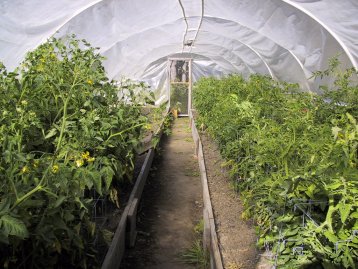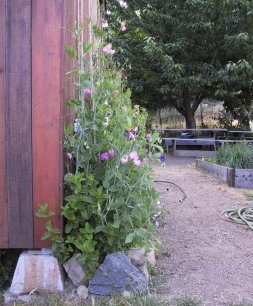
The Compost Heap
News, Views, and Features from the Posh Squash Garden
The Sea Ranch, California
Summer 2002, Issue #4

I am in love with Tarragon, French Tarragon
by Dianne Rasmussen
A little garden in which to walk, and immensity in which to dream.
At one's feet that which can be cultivated and plucked; overhead
that which one can study and meditate upon; some [herbs] on earth,
and all the stars in the sky. ~~~Victor Hugo (l802-l885)
When
the steering committee accepted my offer to assist with our herb
beds, many people set about to help toward the reality of
refurbished and enhanced herb beds. Oh, the
possibility of the joys of gathering beautiful herbs on a warm
pleasant day or after a lovely light rain….The planning
began.
Well,
an herb is not always an herb but can be. Aha!
How then does one define an herb? I turned to the
Oxford English Dictionary and to Rodale and to the Herb Society
of America and finally settled on the simple definition given by
Heinz Grotzke, a master gardener, "my definition of herbs
embraces all plants that can be used for culinary and flavoring
purposes, and for medicinal and veterinary uses, and that lend
themselves to dyeing, smoking, cosmetics, or similar uses…
to set herbs apart from spices, I like to limit the geographical
area for herbs to the northern temperate zones around the
earth." Well, there you have it!
I decided to use this definition and leave the debate to others.
The
older plants needed to be saved throughout the winter and spring
during the construction phase and a plan for new beds and new
herbs was needed. I decided upon a formal
design for the culinary herbs where the individual herbs could be
displayed for use more clearly than in an informal garden.
Straight lines and geometric shapes with symmetry and regularity
are used in a formal setting favored in the fifteenth and
sixteenth centuries. Balance was fundamental. And,
herbs in the earliest monastic gardens were planted in raised
beds for better drainage and as well to bring the herbs closer to
one's senses.
An
informal garden in the unused back corner of the garden would be
planted with medicinal and scented, aromatic herbs and those
culinary herbs which would need room to spread.
In all cases, soil, water and light needs would be considered for
each of the beds. And, as everything is
interrelated in nature, companion planting or use of herbs for
pest control could be a good thing for the whole of the garden if
they grew successfully in the environment.
Ben
and his energetic crew constructed the raised forms quickly, the
enriched soil was loaded within, and the planting began…
In
most cases, herbs included in our herb garden are as old as man.
Their flavor and fragrance, and the promise of good health and
well-being, intrigue and fulfill even today. Tarragon,
chives, marjoram, sages, oreganos, thymes, mints, burnet, savory,
lemon balm… all were found in our old garden and
transplanted successfully to the new beds. And the
lovely old rosemary remained in its cherished place to remind us
of the past as well. The annuals of basils,
chervil, chamomile, parsleys, cilantro and others have burst
forth in abundance within their new surroundings.
Many
new plants have been added of sweet bay, angelica, lemon verbena,
rue, feverfew, culinary lavender, lemongrass, dandelion, lamb's
quarters, even pennyroyal and catnip for our animals' pleasure,
and the many other herbs soon to be labeled; the existing plants
of horseradish, borage, fennel, comfrey; the many edible flowers
such as Johnny jump-ups, violets and pansies, peppery calendula
and nasturtium, clover-like pinks, citrusy marigold, mints,
roses, lovage…
"Herbs are one of nature's many gifts to man. Throughout history, this gift has continually blessed man with its varied virtues, not the least of which is its beauty."
~~~Henry Benson
Oh,
the possibilities of joy! May you fully
enjoy……..

Picky, picky, picky...anyway, a timely reminder now that our beans and peas are coming in. To avoid damage to the vine when you harvest, use both hands -- one to hold the vine to protect it, and the other to detach the pod.
Also, use a pair of scissors when you are going for the leaf-by-leaf kind of picking. When a row flies the green and orange ribbon, be sure to take the whole plant. Dump discard leaves in the compost bin and toss the stump or roots on the heap.

by Chester Case
We
prepped rows without the roaring ministrations of Big Red’s
dervish tines. The rear-tined, power-to-the-wheels, forward and
reverse geared tiller was over to Healdsburg for overhaul. We
hoed, we dug, we hoed some more, we even fired up the rasty
little Mantis to snarl and chew at clods and stir in the
amendments. It was an okay job of row prep. But yes, we nodded,
the fossil-fuel-guzzling, silence-shattering, dust-raising tiller
is definitely a righteous trade-off. Remember “Appropriate
technology”, “Small is beautiful,” “Less is
more”?
It
is hard to imagine essential organic principles compromised by
a mechanical technology as appropriate to our Garden in scale and
character as Big Red.
Big
Red is a TroyBilt Rotovator. It was a gift to the Garden in 1982
from Vernon and Marie Fish. For twenty years it has speeded and
eased our labor in prepping rows. It has been repaired and
re-repaired. Sherm Boring, now deceased, kept Big Red roaring for
years. Ben now keeps it and the other machinery running.
Gardeners
rejoiced, a back issue of The Compost Heap implied, when Big Red
arrived. The early Gardeners were rock-pickin’ fools. A lot
of the heavy lifting had been done in the rock patch by
tractor-pulled plows. A big mechanical “rockpicker” was
brought in to dig up and sift out rocks, big rocks, and toss them
into its truck bed. How big? Jer recalls, “Melon sized.
Bedrock stuff.” Then a Sear Roebuck front-tined, drag-bar
tiller came to the garden. The kind with handlebars like those
old balloon tire bicycles. Jer remembered that machine, too.
“It bucked and jumped that high (a hand way off the ground)
when it hit a rock.”
Since
the Garden first broke ground in 1975, mechanical energy
accomplished what human energy could do only if we approached it
like the Pharaoh. Jer looked out over the burgeoning rows of our
Garden, “We have vastly improved this place as agricultural
land.”
Suppose
Big Red just gave up its ghost. Hypothetically, would we want to
replace it? Ben says a comparable rig costs about $1900 today.
Actually, we would need to replace it. Tractor too much;
front-tine tiller too little. Repair bill and all, we’ll be
glad to hear Big Red rumbling along the rows. Appropriately.

The Posh Squash Steering Committee met Wednesday, July 24, 2002, at the Garden, sharing the tables under the cherry tree at Coffee Break with the Wednesday Crew. Present were: Tom Warnock, Mary Austin, Ken Holmes, Ben Klagenberg, John Horn, and your scribe, Chester Case.
Most of the meeting was devoted to the ongoing project of securing the location of the Garden. The preferred site is the present one, but uncertainties make it prudent to continue to seek alternative sites. Tom reported on the meeting he, Ben and Jer had with Kelly Mason, executor for the Baker estate. With maps and property descriptions to illustrate their presentation, they offered proposals by which the Garden might be able to remain in its present location. Mason indicated she will consider the proposals and respond.
Next, the Committee pondered the letter prepared by Tom and others to send to The Sea Ranch Association Board of Directors. The letter is concise yet thorough and detailed, and summarizes background events and circumstances regarding the Garden’s search for an alternative site on the Ranch before it sets out specific requests to the Association. In view of uncertainties and questions unanswerable at this time regarding cost, water availability, access and potential political opposition, the Committee decided to request the BOD to designate both the Chapel Trail and the Longmeadow sites as potential sites for the Sea Ranch vegetable garden.
On another topic, Tom reported a balance of $4300 in the Garden account. The most recent newsletter incurred the cost of the paper only, as Jackie Morse ran it on her own copier.
Day Leaders were urged to coach Gardeners on harvesting. (See “Picking Reminders” in this issue).
Irrigation supplies have been augmented by ten new 50’ foot lengths of soaker hose. More clamps and connectors are needed. Irrigation matters should be directed to Water Persons John Horn, Ken Holmes and Ben Klagenberg.
Ben took the rototiller to a specialty repair shop in Healdsburg for a transmission overhaul. New belts and tines will be installed. It will be back in service about mid-August. Repairs are estimated at $250-350. In the meantime, the “Mantis” tiller can be used to mix in amendments and help break up the clods. Check with Ben or a Day Leader to learn how to operated this little devil. (More on rototillers in this issue under “Appropriate Technology”).

by Shirley Case
All the wonderful garlic is now stored in our homes in cool, dry places. I thought you might enjoy a bit of information from Chez Panisse Vegetables. Alice Waters writes: "Mature heads of garlic are at their freshest and tastiest from mid-June until fall. Summer is the season when garlic can be used generously. it is the time to roast whole heads slowly with thyme and olive oil until the cloves melt into a puree."
Last year, thinking to make our garlic supply last, we stingily rationed it out. All too well, I fear. We lost too much to the inevitable drying and shrinking that happens. Don’t wait too long to use it. In the fall a green sprout, the germ, begins to form in the center of each clove. The green sprout will give the garlic a slightly bitter and pungent taste. Cut the clove in half and remove the green sprout before chopping and cooking.
Waters’ garlic advice really improved my marinara sauce. I had been sauteeing my garlic with onion when starting a dish. She says, don’t brown garlic, no - add it to the dish you are preparing at the finish to cook gently for only 30-60 seconds. Voila!

From Lita Gitt’s Kitchen
This is also known as "Bundesbahn Bean Soup". Not exactly a likely place to have an extraordinary culinary happening but it was in a German dining car streaking through the German countryside that we first tried this wonderful vegetable soup. And I've been making it every summer since.
1 large onion, finely
sliced
2 tomatoes, chopped
olive oil
1/2 lb. green
beans, cut in half
1/2 C. dried haricot
(white) beans, cooked (canned ones are fine)
2 medium potatoes, cubed
2 small zucchini, sliced
a stalk of celery, diced
1 leek, finely sliced
(the above 5 vegetables are optional and can be altered according to availability and taste)
a handful of vermicelli
or other small pasta
2 cloves garlic
a big handful of basil
leaves
3-5 Tbsps. olive oil
Heat a small amount of
olive oil in a heavy bottomed pan. Add the sliced onion and
sauté gently for 10 minutes or until it becomes translucent.
Add the chopped tomatoes (add a tiny pinch of sugar if these are
not sun ripened). Let them cook a few minutes.Add 3 C.
water or water/broth combination. Season with salt and
pepper and bring to a boil. Add the prepared vegetables and cook
for 15 minutes. Add the vermicelli. Meantime prepare
the sauce (pistou) in a blender or processor by combining the
garlic, basil and olive oil and salt to taste. After
vermicelli has cooked (8 minutes approx.) add the prepared
pistou. Stir and serve. Pass around a bowl of freshly
grated parmesan cheese. 4-6 servings.
